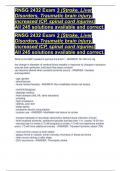RNSG 2432 Exam 3 (Stroke, Liver
Disorders, Traumatic brain injury,
increased ICP, spinal cord injuries)
All 245 solutions available and correct.
RNSG 2432 Exam 3 (Stroke, Liver
Disorders, Traumatic brain injury,
increased ICP, spinal cord injuries)
All 245 solutions available and correct.
What is the MAP needed to perfuse the brain? - ANSWER- 50-100 mm Hg
the change in diameter of cerebral blood vessels in response to changes in pressure
ensures brain perfusion and blood flow stays constant
can become altered when cerebral ischemia occurs - ANSWER- Cerebral
autoregulation
- age, gender
- ethnicity/race
- family history/heredity - ANSWER- Non-modifiable stroke risk factors
- HYPERTENSION
- diabetes mellitus
- heart disease (afib, MI, valve disorders)
- smoking
- high cholesterol
- obesity, poor diet
- sleep apnea
- excessive alcohol consumption
- cocaine use - ANSWER- Modifiable risk factors for stroke
- transient episode of neurologic dysfunction without acute infarction of brain
- brief localized ischemia, symptoms typically last less than 1 hr, usually 10-20 min
- warning sign for stroke (1/3 will progress to stroke, 1/3 will not experience another
event, 1/3 will have additional events) - ANSWER- Transient ischemic attack (TIA)
- most common cause of brain attack
- plaque forms in vessels, lumen narrows, thrombus or blood clot forms
- often occurs during or after sleep
- 25% recurrence - ANSWER- Thrombotic stroke
,RNSG 2432 Exam 3 (Stroke, Liver
Disorders, Traumatic brain injury,
increased ICP, spinal cord injuries)
All 245 solutions available and correct.
- sudden onset with immediate deficits
- Afib, MI, IE, valvular prostheses, rheumatic heart disease
- commonly occurs during periods of activity
- patient remains conscious
- recurrence is common - ANSWER- Embolic stroke
result from bleeding into brain tissue or into the subarachnoid space or ventricles
13% of all strokes - ANSWER- Hemorrhagic strokes
- HTN is most common cause, other causes anticoagulant therapy, brain trauma,
tumors, vascular malformations
- onset with activity, poor prognosis
- sudden onset of symptoms, progression of symptoms over minutes to hours -
ANSWER- Intracerebral hemorrhage
- severe headache, nausea and vomiting, HTN
- decreased LOC, hemiparesis
- hemiplegia, fixed dilated pupils, coma, death - ANSWER- ICH manifestations
- intracranial bleeding into the cerebrospinal fluid-filled space between the pia mater and
arachnoid mater
- commonly caused by rupture of a cerebral aneurysm (congenital or acquired - trauma
or cocaine)
- incidence increases with age, higher in women
- rebleeding before surgery is common
- vasospasms 6-10 days after bleed - ANSWER- Subarachnoid hemorrhage
- "worst headache of one's life"
- loss of consciousness may or may not occur
- can range from alert to comatose
- nausea, vomiting, seizures, stiff neck
- CSF would show blood
- prognosis poor - ANSWER- SAH manifestations
- non contrast CT (distinguish btwn hemorrhage and ischemia)
- CT angiography (estimate perfusion)
- MRI (more effective with ischemia, determine extent of injury)
- MRA
- cerebral angiography (source of SAH)
- transcranial doppler (blood flow velocity)
,RNSG 2432 Exam 3 (Stroke, Liver
Disorders, Traumatic brain injury,
increased ICP, spinal cord injuries)
All 245 solutions available and correct.
- echocardiogram
- lumbar puncture
- carotid ultrasound
- ECG
- CXR
- EEG
- Labs: blood glucose, INR, electrolytes, BUN/creatinine, CBC with plt, troponin,
PTT/INR - ANSWER- Stroke diagnosis
- lodging embolus
- vasospasm
- inducing further hemorrhage
- allergic rxn to contrast media - ANSWER- Cerebral angiography risks
Medication
- tPA
- anticoagulants to prevent further clot formation: antiplatelet (ASA, clopidogrel),
antithrombolytic (warfarin, apixaban, dabigatran)
- statins
- BP meds
Treatments
- endovascular
- merci clot removal - ANSWER- Ischemic stroke treatment
Medication
- antihypertensive (maintain SBP < 160 mmHg)
- seizure prophylaxis (phenytoin, levetiracetam, lamotrigine)
- nimodipine (prevention of vasospasms, calcium channel blocker, assess BP before
admin)
Treatments
- evacuate the hematoma
- clipping/coiling
- ventriculosotomy - ANSWER- Hemorrhagic stroke treatment
- ischemic stroke medication
- tx must be initiated promptly after CT scan to R/O bleed
- reestablish blood flow through blocked artery
- IV tPA must be administered within 3-4.5 hrs of symptom onset
- 0.9mg/kg infused over 1 hr, never to exceed 90mg; 10% as initial bolus over 1 min
Monitor:
, RNSG 2432 Exam 3 (Stroke, Liver
Disorders, Traumatic brain injury,
increased ICP, spinal cord injuries)
All 245 solutions available and correct.
- angioedema, systemic bleeding, anaphylaxis
- maintain SBP < 185 mmHg during and 24 hrs after
- check BP every 15 min x2 hrs, 30 min x 6 hrs, then every hr x 16 hrs
Exclusion criteria:
- coagulation disorders
- recent GI bleed, stroke or head trauma, surgery, or internal bleeding, pregnancy, low
platelets, infarction too big (more than 30% of brain) - ANSWER- tPA
- treatment for hemorrhagic stroke)
- opening into cranium, removal of bone flap
- drain blood, relieve ICP
- monitor for any neuro changes and BP - ANSWER- Craniotomy (hematoma
evacuation)
- used to occlude aneurysm
- immediate evacuation of aneurysm-induced hematomas or cerebellar hematomas >
than 3 cm
- metal coil is inserted into lumen of aneurysm
- prevents blood from circulating through aneurysm, reducing risk of rupture - ANSWER-
Coiling (hemorrhagic stroke)
- immediate evacuation of aneurysm-induced hematomas, or cerebellar hematomas >
3cm
- reduces blood pulsations to aneurysm
- eventually, thrombus forms within aneurysm
- aneurysm becomes sealed off - ANSWER- Clipping (hemorrhagic stroke)
- reduce salt, low in fat and cholesterol
- maintain a normal body weight
- maintain a normal blood pressure
- increase level of physical exercise
- avoid cigarette smoking or tobacco products
- limit consumption of alcohol to moderate levels
- antiplatelet agents (ASA most frequent for stroke prevention) - ANSWER- Stroke
health promotion
the surgical removal of the lining of a portion of a clogged carotid artery leading to the
brain to prevent impending cerebral infarction - ANSWER- carotid endarterectomy
- insertion of a balloon to open stenosed artery




